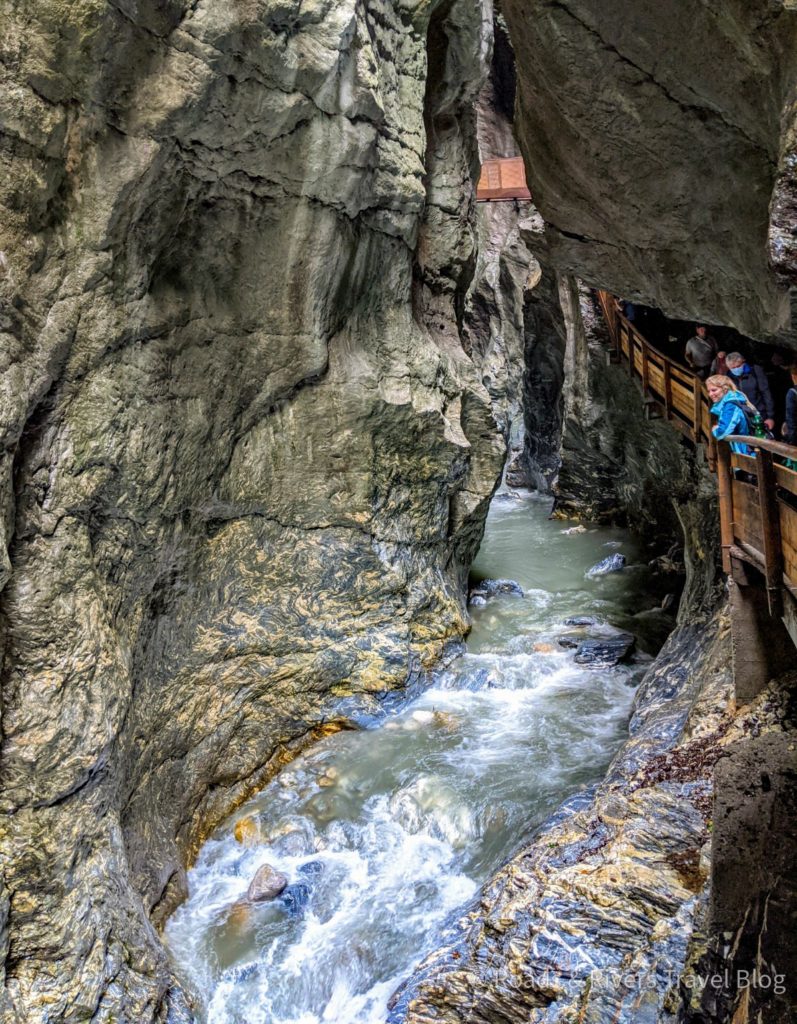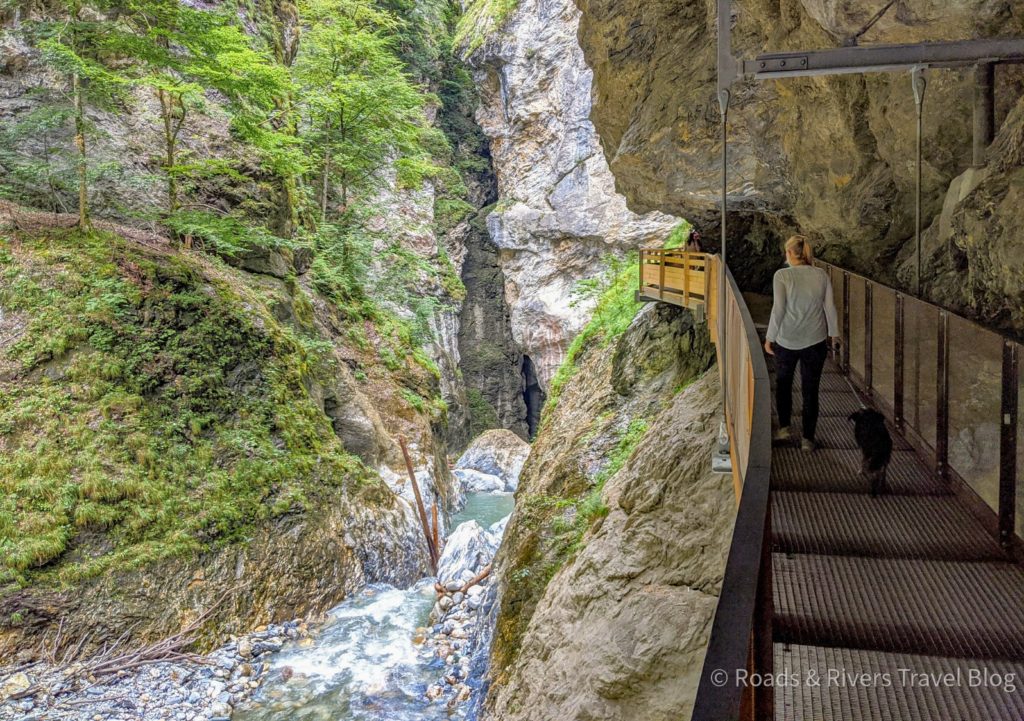The Liechtenstein gorge in the Grossarl Valley is one of the longest and deepest gorges in the Alps and the most visited gorge in Salzburg Region in Austria. With a total of 4000 meters, the Liechtensteinklamm is one of the longest gorges in the Alps, with about 1000 meters accessible to visitors. The cliffs are up to 300 meters high and in some places the gorge is only a few meters wide. At the end of the hike through the Liechtenstein gorge, a large waterfall awaits you, thundering into the valley.
A unique experience that is unparalleled in Austria. If you are a good walker, you can get to this waterfall within 45 minutes on the secured boardwalks. On the same way you have to walk back to the exit. The Liechtenstein gorge is not a circular route. Where is the best place to park, when is the best time to arrive and more tips we will tell you in our travel report.
Liechtenstein gorge: How to get there and parking tips

Coming from Salzburg on the highway in the direction of Villach, you reach Bischofshofen before the Tauern Tunnel. Exit here and continue for 6 kilometers to St. Johann im Pongau. There follow the signs Liechtensteinklamm, 4 kilometers outside the center of St. Johann, the free parking spaces (Google Maps) are quickly reached.
There are a total of 4 parking lots (P1 to P4 ) of which the most distant (P4) is also really quite far away. If you come late in the morning (or even later) to the gorge, then you will probably be guided by the friendly parking attendants directly to the first or with luck to the second parking lot and then have to walk quite far and steeply uphill to the entrance of the Liechtensteinklamm. This can be quite tiring, especially with small children. We therefore advise you to be at the gorge as early as possible, preferably before 10 a.m., in order to have the possibility to drive to the last parking lot directly in front of the main entrance.
Liechtensteinklamm: The History
Work on making this gorge accessible began as early as 1875. This was done by the members of the Pongauer Alpenverein. Since the money ran out after some time, the workers started looking for other sources of money. Finally, they turned to Prince Johann II of Liechtenstein (the mini-state between Austria and Switzerland), who ran a hunting farm in nearby Großarl. The prince apparently liked the idea of the gorge and donated 600 gulden for its further development.
With this injection of money, the gorge could be opened as early as 1876. Due to the prince’s generous donation, the gorge, which was once called Großarlerklamm, was renamed Liechtensteinklamm. In the first year, 10,000 visitors are said to have come to the Liechtensteinklamm. Since then there have been over 10 million and in the last years before the closure about 200,000 per year!
Accident in the Liechtensteinklamm and reopening in 2020
For more than 3 years, the most beautiful gorge in Austria was closed because of an accident that occurred in May 2017. There was a landslide that damaged a bridge over the gorge.
No one was seriously injured, but several people had to be brought to safety by mountain rescue via an emergency exit. The administration hoped to quickly reopen the gorge to visitors, but the work dragged on and the safety concept was revised and improved several times.
It was not until June 2020 that the Liechtensteinklamm was once again open to visitors after extensive construction and renovation work. The highlight of the now renovated Liechtensteinklamm is the truly impressive “Helix” staircase, a spiral staircase made of Corten steel that spirals down to a depth of 30 meters.
In the course of the renovation, a total of three tunnels, four viewing galleries and 60 additional rockfall nets with a total length of 1,100 meters were also built. These measures also definitely create a good feeling of safety in this incredibly deep gorge and, in our opinion, also justify the entrance fee of 10 Euro.
The landmark of the gorge: The Helix
This spiral staircase (also called Helix) was only built with the renovation work in 2020 in the Liechtensteinklamm. With it, a dangerous spot is bypassed, where in 2017 the rockfall blocked the gorge. However, the spiral staircase serves another purpose: it serves as a great photo motif and also as a landmark of the gorge.
From the top, you can take great photos of the helix and thus have an interesting contrast to the imposing rock walls around you. The umpteen steps of the helix are (thanks to the grid stairs) not very easy to walk and also for dogs or even small children difficult to climb. So small children or dogs should rather be carried here.
Our Hike through the Liechtenstein Gorge
Since we were lucky enough to be able to drive through to the top parking lot, we didn’t have far to go to the main entrance of the gorge. There is first a big toilet house (which is also the only one of the whole hike) and a small souvenir store. After a few meters then comes the actual entrance and also a large restaurant.
Although we were already there before 10am, many other tourists were already on their way and the parking lots were filled accordingly. After we went through the electronic revolving gate (right next to it you can buy tickets), you can already guess the rushing water of the Ache (which, by the way, later merges into the Salzach and flows through the impressive Salzachöfen Gorge) to the right of the secured hiking trail. It is still relatively quiet, but the imposing rock walls are already towering above us.
Over the millennia, the water has dug itself up to 300 meters deep into the gorge, and the hiking trail also runs relatively deep and thus close to the water. Because of this and because of the mostly very narrow gorge, the blue of the sky recedes into the distance. It gets really dark.
Again and again water drips from the ceiling, which is sometimes ominously close above our heads and the sound of the water just a few meters below us is now unmistakable. The path is partly quite narrow and because of the many tourists we have to take our dog Schoko several times to the side or even carry, because otherwise it is simply too crowded to let people pass us without problems. We run through tunnels, over bridges and have again and again fantastic views of the gorge and the raging river below us.
Down the Helix
About in the middle of the gorge we reach the spiral staircase known as the Helix. Here we have to carry Schoko, as he can’t walk very well on the grating. The stairs are quite steep and Sabrina sweats a lot when she puts Schoko down at the bottom of the stairs. (To my excuse: I was busy with the camera)
After a few hundred meters we finally reach the goal of the hike (although here, of course, the path is actually the goal): the waterfall. There is a small picnic area with benches and tables set up and we also rest for the way back. Since the hike through the Liechtensteinklamm is not a circular route, we have to go back the same way.
Overall, we liked the hike very much and the view of the steep rock walls and the roaring river is unparalleled in Austria. But since it was already very crowded and you do not have much room to stand on the sometimes very narrow paths, it was quite stressful. One is actually always driven forward by the people running behind one.
Rarely does one have room to step aside and take pictures or even to give the dog a break. Therefore, we felt the visit to the Liechtenstein gorge as something exhausting. Also, I would recommend dogs that are not very eager to run rather leave in the hotel. Otherwise it could be too stressful on the narrow paths of the Liechtensteinklamm.
Beautiful Hikes in the Vicinity
If you want to do more hikes and excursions nearby, we can highly recommend the Hike around the Bluntau lake. There you walk in picturesque silence around 2 crystal clear lakes and are framed by imposing rock faces. Or go to the Gollinger waterfall this also offers a small, but very fine, hike through a dense forest. The waterfall itself is also very high and impressive and should not be missed on any tour of the Salzburger Land.
Overnight stay near the Liechtenstein Gorge
We had originally planned only 3 nights in the Hotel Pass Lueg*, then it became 5. We have simply felt like home in the small, family-run pension. The hotel is located directly in the mountains and is the starting point for various hikes. Also, the entrance to the gorge of the Salzachöfen is right next door. While you can strengthen yourself in the morning with a delicious breakfast with many homemade treats, you can relax after the hikes in the free wellness area in the sauna or steam sauna.
The cozy Hotel Pass Lueg at Booking*
Things to know about the Liechtenstein Gorge
Visit with dog
It is possible to bring your dog to the Liechtensteinklamm. You must keep your dog on a leash, but there is no obligation to use a muzzle.
Visit with small children
Children will love the hike through the Liechtenstein gorge. The hiking trail through the gorge is very strenuous, but if you carry your child you from time to time, there should be no problems. However, you will not get through the gorge with a stroller. You should also let your children go to the toilet at the beginning of the hike. Later there are no more toilets.
Is the hike to the Liechtenstein Gorge strenuous?
If you are good on foot, then the hike should not be a problem. However, if you are not in good shape, or if you have impairments when walking, then you will not have it easy. In the gorge there are about 440 steps to climb and about 100 meters of altitude to overcome. On the way there are no real possibilities to sit down.
Entrance Fees and Opening Hours
The Liechtensteinklamm is open between May and October. In each case from 09 – 18 o’clock. In winter the gorge is closed. The entrance fee is 10 Euro for adults and 5,50 Euro for youths/children. With the SalzburgCard you get in for free. You should, if possible, arrive outside the peak hours from about 10 to 14 clock!










